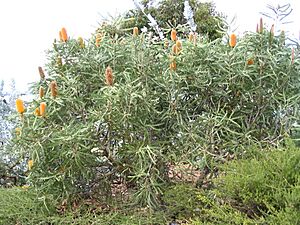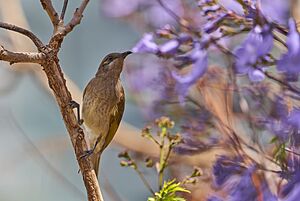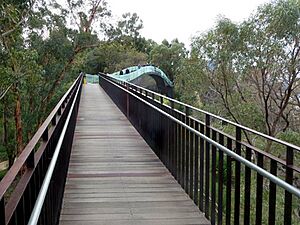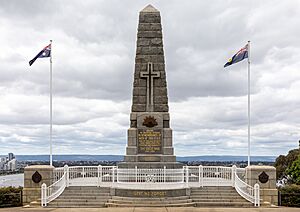Mount Eliza (Western Australia) facts for kids
Quick facts for kids Mount Eliza |
|
|---|---|
 |
|
| Highest point | |
| Elevation | 103 m (338 ft) |
| Naming | |
| Native name | Error {{native name}}: an IETF language tag as parameter {{{1}}} is required (help) |
| Geography | |
|
Lua error in Module:Location_map at line 416: Malformed coordinates value.
|
|
| Location | Perth Western Australia |
| Geology | |
| Age of rock | Pleistocene ~ 40,000 years |
| Mountain type | Hill |
Mount Eliza is a hill that looks over the city of Perth, Western Australia. It is part of Kings Park, a very large and famous park. The local Noongar people call it Kaarta Gar-up and Mooro Katta.
Mount Eliza is a super popular place, with over five million visitors each year. People come for big events like the Anzac Day Memorial service and the Australia Day fireworks. Visitors also love its amazing nature, long history, and cool landmarks.
Contents
What's in a Name?
The Noongar people, who are the traditional owners of this land, have special names for Mount Eliza. They call the top of the hill Mooro Katta and Kaarta Gar-up. The area at the bottom, on the south side, is known as Gooninup. This spot is very important for Noongar ceremonies and stories.
In 1827, a British officer named James Stirling explored the Swan River. He named the hill Mount Eliza after Eliza Darling, who was the wife of the Governor of New South Wales. Later, in 1901, Perth Park was renamed Kings Park to honor the new king, Edward VII.
Exploring Mount Eliza's Nature
How Mount Eliza Was Formed
Mount Eliza is part of a system of sand dunes called the Spearwood Dunal system. These dunes were created about 40,000 years ago during ice ages and warmer periods. The soil here is mostly yellow-brown sand over Tamala Limestone. This limestone formed as calcium carbonate washed out of ancient beach sands over time.
Scientists have studied the soil and found that it has different types of sand and depths. This variety helps different plants grow. The limestone bases are now visible because the Swan River has moved over many years.
Amazing Plants of Mount Eliza
Mount Eliza is home to 326 different types of native plants. That's almost 15% of all the native plants found in the Perth area! You can find three main plant groups here: limestone heathland, banksia woodland, and plants that like moist areas.
Before European settlers arrived, the bushland had many tall Tuart, Jarrah, and Marri trees. Now, Banksia species are more common. This change is natural, but some people think human activity has made it happen faster. Over 265 types of fungi have also been found here, and most of them are native to the area.
Wonderful Animals of Mount Eliza
Kings Park has a huge variety of animals, especially birds and insects. There are over seventy kinds of birds, twenty types of reptiles, and hundreds of different invertebrates (animals without backbones) living in the bushland of Mount Eliza.
Studies have shown that the Brown Honeyeater and Red Wattlebird are two of the most common birds on Mount Eliza. More birds, especially those that eat nectar, visit during spring when many plants are flowering.
Some special invertebrates, like the Scarp Snail and the trapdoor spider, only live on the Mount Eliza escarpment. These creatures are very important to protect.
Mount Eliza's Rich History
Aboriginal Dreamtime Stories
The Noongar people have ancient stories about Mount Eliza. They believe that the Wagyl, a powerful spirit often seen as a Rainbow Serpent, rose from Ga-Ra-Katta (Mount Eliza's steep slope). The Wagyl then created the Swan River (Derbarl Yerrigan) and the Canning River (Djarlgarro Beelier). The Wagyl is a creator spirit, giving life to the land.
Gooninup, at the foot of Mount Eliza, is a sacred place. It is believed to be where the Wagyl rested after creating the Swan River.
Early European Settlement
In 1834, Gooninup was set aside as a teaching camp for Aboriginal people. However, some records suggest it was also a way to manage growing tensions between settlers and Noongar people. By 1838, many Noongar people had either passed away or moved from the area.
Later, a law was made that stopped Aboriginal people from entering the Perth Prohibited Area without special permission. This law restricted access to Gooninup for over a hundred years, until it was removed in 1954.
In 1827, Captain James Stirling explored the Swan River, hoping to start a new colony. He climbed Mount Eliza and was amazed by the beautiful views of the country, the winding river, and distant mountains.
The Colony of Western Australia was founded in Perth on June 1, 1829. It is said that Noongar elder Yellegonga welcomed the new settlers.
In 1832, Surveyor General John Septimus Roe decided that Mount Eliza should be kept for public use and not for cutting timber. However, in 1836, the first timber exported from the colony was Jarrah wood logged from Mount Eliza. In 1896, parts of Mount Eliza were added to Perth Park, which later became Kings Park.
What Mount Eliza is Used For
Fun for Visitors
Mount Eliza offers many fun activities for tourists in Kings Park. You can learn about Aboriginal culture, go on guided walks, explore special walkways, and enjoy amazing views.
Lotterywest Federation Walkway
Opened in 2003, this 52-meter-long bridge is made of steel and glass. It's one of Kings Park's most famous attractions. The walkway helps visitors see how Mount Eliza connects the city to the natural bushland. It also helps people appreciate the history of the landscape. The walkway includes Noongar artwork and ends at a performance area called Beedawong.
Beedawong
Beedawong means "celebration" or "meeting place." It's a stone amphitheater (an open-air stage) on top of Mount Eliza, near the Federation Walkway. Built in 2003, it's a place for Noongar cultural events and other visitor activities.
Important Memorials
The Western Australian War Memorial is located at the top of Mount Eliza. It was officially opened on November 24, 1929. The memorial is a tall granite obelisk (a stone pillar) surrounded by a covered walkway. Inside, you can find the names of over 7,000 people who died serving their country.
The memorial area also includes a court of contemplation, a flame of remembrance, and a pool of reflection. More than 40,000 people visit this memorial each year for the Anzac Day Dawn Service.
Water for Perth
In 1895, 450 acres of land were taken from the public park to build the Mount Eliza reservoir. This reservoir was needed to supply water to Perth, which was growing very quickly. The first reservoir was built in 1896 and could hold 3,573 cubic meters of water.
Over the years, more reservoirs were built. The original reservoir was replaced in 1935 by new ones that are still a key part of Perth's water supply today. Mount Eliza's reservoirs help store and distribute water from larger sources like the Victoria reservoir.





